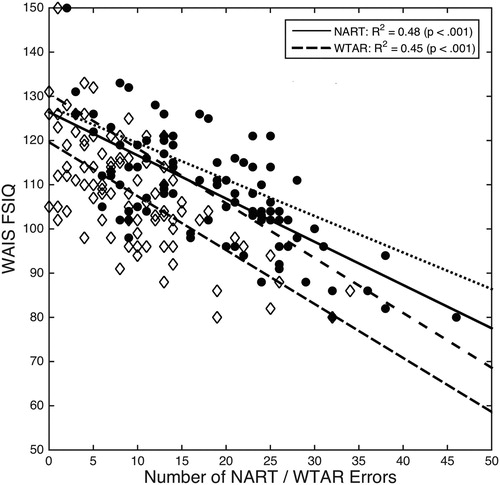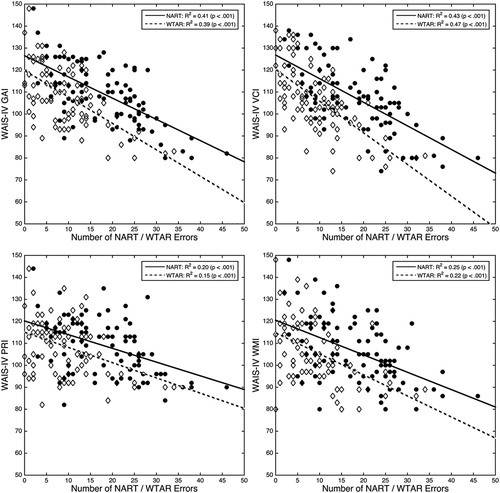Figures & data
Figure 1. Number of academic publications in which NART-R (solid line), WTAR (dashed line) and Advanced Clinical Solutions/Test of Premorbid Functioning (ACS/TOPF) (dotted line) neuropsychological tests were cited for each year from 2011 to October 2017. Google Scholar (5 October 5 2017) citation counts based on [Nelson and Willison (Citation1991). National Adult Reading Test (NART). NFER-Nelson] for NART-R; [Wechsler (Citation2001). Wechsler Test of Adult Reading: WTAR. Psychological Corporation] for WTAR, and combined counts from [Pearson (Citation2009). Advanced Clinical Solutions for WAIS-IV and WMS-IV: Administration and scoring manual. The Psychological Corporation, San Antonio] and [Wechsler (Citation2011). Test of Premorbid Functioning. UK Version (TOPF UK). UK: Pearson Corporation] for ACS/TOPF.
![Figure 1. Number of academic publications in which NART-R (solid line), WTAR (dashed line) and Advanced Clinical Solutions/Test of Premorbid Functioning (ACS/TOPF) (dotted line) neuropsychological tests were cited for each year from 2011 to October 2017. Google Scholar (5 October 5 2017) citation counts based on [Nelson and Willison (Citation1991). National Adult Reading Test (NART). NFER-Nelson] for NART-R; [Wechsler (Citation2001). Wechsler Test of Adult Reading: WTAR. Psychological Corporation] for WTAR, and combined counts from [Pearson (Citation2009). Advanced Clinical Solutions for WAIS-IV and WMS-IV: Administration and scoring manual. The Psychological Corporation, San Antonio] and [Wechsler (Citation2011). Test of Premorbid Functioning. UK Version (TOPF UK). UK: Pearson Corporation] for ACS/TOPF.](/cms/asset/3c989165-566b-4fca-b98c-e0270f8e9dbd/pnrh_a_1445650_f0001_ob.jpg)
Table 1. WAIS-IV performance and demographics.
Table 2. Correlations and direct comparison among hold and no hold measures.
Table 3. NART and WTAR raw error and predicted and observed WAIS-IV performance.
Table 4. Correlations of NART and WTAR performance with WAIS-IV FSIQ, index and subtest scores.
Figure 2. Linear correlation between National Adult Reading Test/Wechsler Test of Adult Reading (NART/WTAR) errors and Wechsler Adult Intelligence Scale – Fourth Edition (WAIS-IV) full-scale IQ (FSIQ). The original published estimates of WAIS (dotted) and WAIS-R FSIQ (wide-space dashed) from the manual (Nelson & Willison, Citation1991) are included for comparison.

Figure 3. Scatterplots showing linear correlations relating number of the National Adult Reading Test (NART) and Wechsler Test of Adult Reading (WTAR) errors to (A) General Ability Index (GAI); (B) Verbal Comprehension (VCI); (C) Perceptual Reasoning (PRI); and (D) Working Memory (WMI). Processing speed (PSI) has been excluded.

